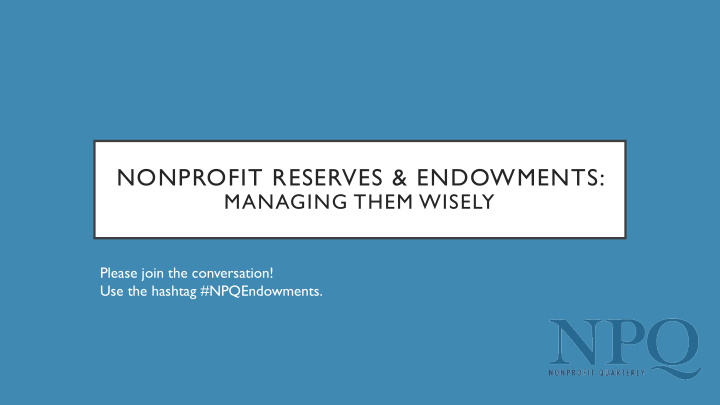



NONPROFIT RESERVES & ENDOWMENTS: MANAGING THEM WISELY Please join the conversation! Use the hashtag #NPQEndowments.
MEMBERSHIP & LOGISTICS • Welcome to all Leading Edge Members! • Learn more about membership at nonprofitquarterly.org. • Today’s webinar is being recorded. You will receive the slides and recording in two days. • We rely on your feedback to shape our programming. Take the survey that pops up immediately following the webinar. Thank you! • The social media hashtag for this webinar is #NPQEndowments. 2
ABOUT PAUL SUSSMAN • An independent consultant to nonprofit organizations, small businesses, and philanthropies • Formerly: • CFO, Tenderloin Neighborhood Development Corp. (assets of over $750 million) • Founding President, Northern California Community Loan Fund (pioneering social investment institution) • Currently: • Board Member, Community Music Center 3
TODAY’S DISCUSSION 1. Problems and opportunities: What are you solving for? 2. What is an endowment? 3. Building an endowment 4. Managing an endowment 4
PROBLEMS & OPPORTUNITIES 5
PROBLEMS & OPPORTUNITIES • Cash Flow Management • Stable Operating Funding • Investment • Risk Buffer • Capital Needs • Long-Term Preservation 6
FOR EACH PROBLEM/OPPORTUNITY, 7 QUESTIONS: 1. Target: How much is needed? 2. Timing: How much is needed when? 3. Liquidity: What is the likely lead time for use? 4. Risk: How much over what period? 5. Investment: What asset allocation and investments are appropriate? 6. Management: Who makes which decisions re: investment and use? 7. Segmentation: Co-mingling/overlap/segmenting your funds? 7
WHAT IS AN ENDOWMENT? 8
WHAT IS (AND IS NOT) AN ENDOWMENT? • Legal vs. common-sense understandings • Long term investment horizon ( though may allow for short term responses ) • Use of earnings and preservation of principal ( with exceptions ) • Not necessarily permanently restricted gift • Invested and used intentionally through formal processes 9
MISCONCEPTIONS & MYTHS • None of the principal can ever be touched. In fact, it depends. • We have to distribute a minimum amount like a foundation. No. • 5% annual cash throw off is a good rule of thumb. Not anymore. • An endowment will cannibalize our annual fund. Not necessarily. • I can’t use my endowment in an emergency. Not necessarily. 10
TYPES OF ENDOWMENT FUNDS • Unrestricted endowment: can be spent, saved, invested and distributed at organization’s discretion • T erm endowment: principal can be expended after a period of time or a defined event • Quasi -endowment: formally designated by board (but not by donor) • Restricted endowment: principal held in perpetuity; earnings can be expended • Sometimes specific use of earnings is also restricted • Specific use can be fungible or not 11
BUILDING AN ENDOWMENT 12
SHOULD YOUR ORGANIZATION BUILD ONE? • Do you have the capacity? “You don’t need my money; you’ve got an • Internal skills, systems, people, culture endowment!” • Donor base to support it • Opportunity cost of raising and managing it • Current spend on mission vs. $ locked up in an endowment • Intergenerational equity • Time value of money if you don’t/can’t reinvest & grow it • Synergy or cannibalization re: annual fundraising 13
SOURCES FOR BUILDING AN ENDOWMENT • Transfer of retained surplus • Set-aside in annual budget • Transfer windfall surplus (bequest, one-off transactions) • Capital campaign 14
MANAGING AN ENDOWMENT 15
REGULATORY & COMPLIANCE • Recording, tracking, and complying with types of restrictions • GAAP audit disclosure requirements • Conflicts of interest • Support or endowment corporations • Fiduciary requirements (UPMIFA) 16
A BIT MORE ON UPMIFA Uniform Prudent Management of Institutional Funds Act QUESTION : What is a “fiduciary”? A fiduciary is someone who holds a legal or ethical relationship of trust and prudently takes care of money for another person or entity. QUESTION : What is a “prudent” person? A prudent person acts “in good faith and with the care an ordinarily prudent person in a like position would exercise under similar circumstances.” UPMIFA provides checklists for what a prudent person must consider re: investing, spending, and delegating. 17
ELEMENTS OF AN INVESTMENT POLICY (1 OF 2) • Overall Objectives • Cash Flow Expectations & Payout • Investment Parameters • Time Horizon • Diversification • Risk • Permitted & Prohibited Investments • Screens & Socially Responsible Guidelines • Cost • Asset Allocation 18
ELEMENTS OF AN INVESTMENT POLICY (2 OF 2) • Performance Evaluation & Benchmarking • Selection/Replacement of Advisor/Manager • Decision-making Authority of Advisor/Manager • Responsibilities & Roles: • Board of Directors • Committee(s) • Staff (Executive Director, Finance Director, etc.) • Advisor/Manager 19
A HIERARCHY OF INVESTMENT DECISIONS 1. Risk T olerance Decision Hierarchy 2. Investing Style 3. Advisor/Manager 4. Asset Allocation 5.Products/Positions 20
TAPPING RESERVES & ENDOWMENTS IN A CRISIS • Continuously re-project cash flow. • Be clear about your restriction record- keeping. • Be clear about restricted corpus vs. accumulated but undistributed earnings. • Consider asking donors to remove or change restrictions. • Can you borrow, secured by your endowment? • What’s your bottom line for running down your reserves? It should not be $0. 21
PLEASE COMPLETE YOUR BRIEF EVALUATION NOW Thank you for joining us! 22
Recommend
More recommend